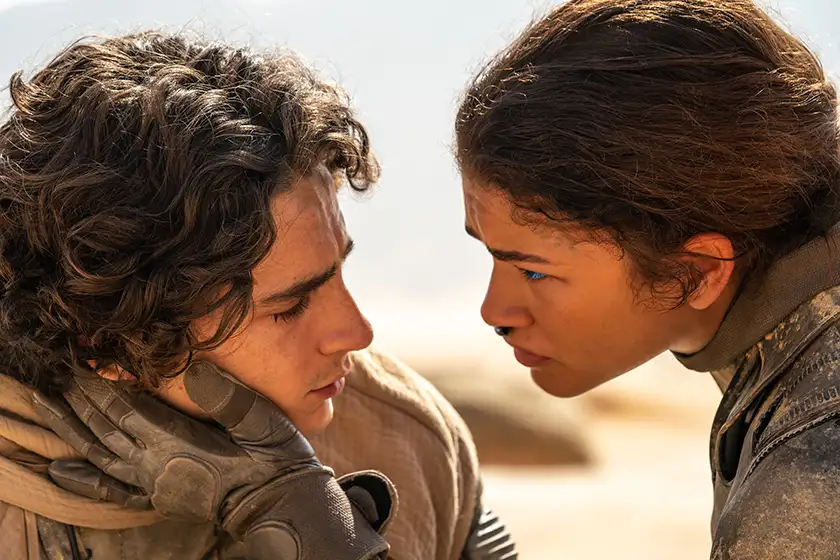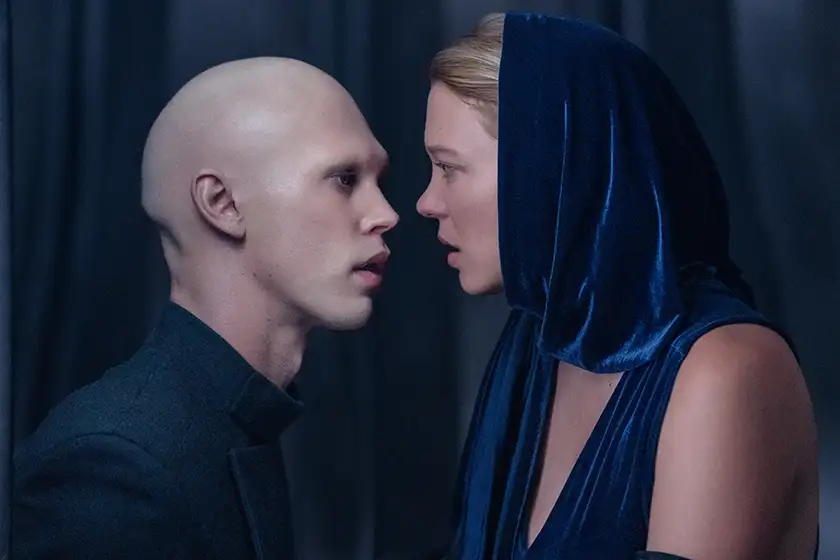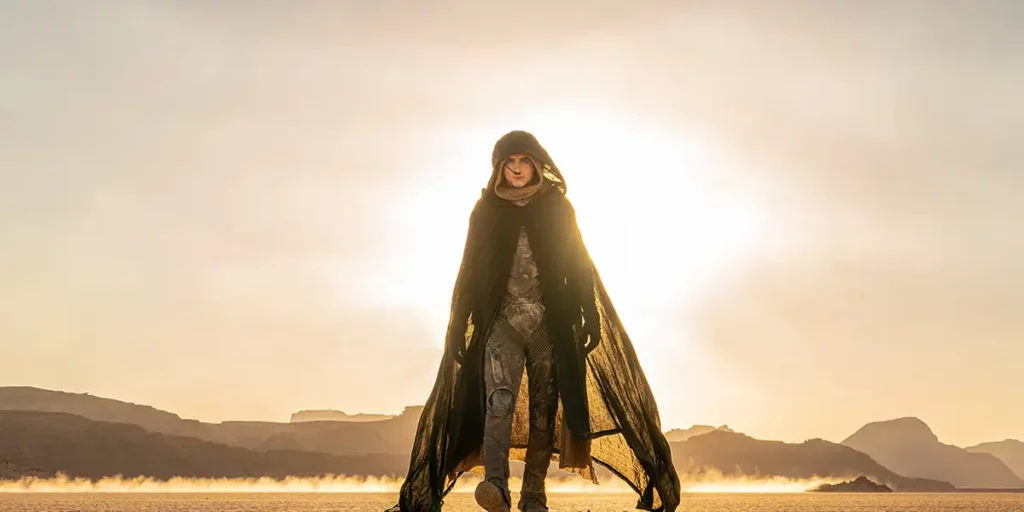With precise vision and execution, Dune: Part Two is the kind of boundary-pushing blockbuster epic that will make you question how Villeneuve managed to achieve it in the first place.
Frank Herbert’s 1965 sci-fi novel “Dune” is one of those stories considered unadaptable by anyone familiar with the books. Unadaptable, not only due to its ambitious and massive scale but also because it carries themes that are usually not marketable to the general audience. And those themes are what make Herbert’s epic shine. “Dune” is a cautionary tale. One that asks readers to be wary of government and of following charismatic leaders – that no person in the universe should have a ridiculous amount of political and religious power over others. It reflects humanity’s nature of idolizing dangerous figures and the inability to learn from our violent history. Denis Villeneuve understands these themes, and this makes him the perfect candidate to bring Dune, and now Dune: Part Two, to the screen.
Dune: Part Two continues Paul Atreides’ (Timothée Chalamet, Wonka) mythical journey. He joins forces with Chani (Zendaya, Challengers) and Stilgar (Javier Bardem, The Little Mermaid), a Fremen leader, while seeking revenge against the conspirators who killed his father, Duke Leto (Oscar Isaac, Moon Knight), and nearly destroyed House Atreides. Forced to choose between the love of his life and the fate of the known universe, Paul must prevent a terrible future only he can foresee – leading the population of the planet Arrakis to view him as a messiah who has come to liberate them from misery.
If Dune (2021) tends to hold the audience’s hand as it introduces them to the film’s set of rules, characters, and worlds, Denis Villeneuve completely lets us go with Dune: Part Two by entrusting we’ll follow along and embrace the dense storytelling he’s adapting. What might be more impressive than the craftsmanship from every production department is that a prominent studio agreed to make such soul-shattering blockbusters. Villeneuve’s vision seems uncompromised. From the opening ten minutes, Dune: Part Two is tonally different. While Dune blends whimsy with drama, Part Two is more interested in the cruel intentions of our “heroes,” setting the stage for character conflict.
Chani is one of many key players that pose a conflict in this bitter sci-fi epic. When most Fremen spend their time trying to convince others that Paul is their prophetic savior, the Lisan al Gaib, Chani believes her people can liberate themselves by fighting together. It creates tension when she confronts Lady Jessica (Rebecca Ferguson, Silo) and Stilgar’s beliefs, and her relationship with Paul becomes much more interesting than on the page. Chani isn’t another blind believer. She has her agenda, making Paul’s decision to reject or embrace the messiah persona even harder. Through her character, Zendaya adds a lot of heart to an otherwise incredibly bleak film.

I was pleasantly surprised by Javier Bardem and how much he got me to care for Stilgar. He’s good in Dune, but Part Two gives him more to chew on. There is a sweetness to his firm faith in Paul that would be admirable if it wasn’t dangerous. That same statement can be applied to every other returning cast member from the last installment. From Ferguson’s Lady Jessica to Josh Brolin’s (Deadpool 2) Gurney Halleck, Villeneuve showcases how harmful fanaticism is by almost making you disgusted at the actions of characters you were previously rooting for in Dune.
Newcomers to the franchise Austin Butler (Elvis) and Florence Pugh (Oppenheimer) have the difficult task of leaving an impression with the limited screen time each has, compared to the set of characters directly linked to Paul. Butler as the psychotic Feyd-Rautha Harkonnen is the highlight of the two, with a performance that walks the fine line between cartoonishly evil and legitimately terrifying. His encounter with Paul is reminiscent of the last duel in Ridley Scott’s Gladiator, with choreography that pushes its PG-13 rating. Pugh is solid, although the script appears to be mainly concerned with giving her exposition dumps.
Dune is commended for its technical achievements and supporting cast, but I rarely see that same praise for Timothée Chalamet himself. It’s easy to dismiss his work in the first half of this narrative because he plays the typical reluctant hero with noble intentions. We’ve seen that part brought to life by numerous actors, and Chalamet doesn’t necessarily change the formula, per se. He’s good at showing the tender side of Paul, though, which, in hindsight, is far more effective after his arc in Dune: Part Two. The constant moral dilemma he encounters is beautifully tragic in how he evokes sympathy despite his descent into darkness. Chalamet proves he’ll nail Paul’s somber characterization in an adaptation of “Dune: Messiah.”
Dune: Part Two does have significant changes from Herbert’s novel that didn’t click with me. Without diving into spoilers, these changes relate to a character close to Paul, who has a more prominent role in subsequent books. Their physical presence in the novel has notable repercussions for our antagonists, which later torment said character. That part is downsized to a supernatural presence here, begging to ask how the character’s arc, later on, will be handled if they don’t perform the very action that’ll haunt them. The changes make sense for the structure Villeneuve has chosen for this adaptation. Yet, it feels like a massive missed opportunity because a filmmaker of his caliber would have executed this storyline with distinguished effect.
Denis Villeneuve’s vision is singular, yes. But his direction is only as good as the talented artists he surrounds himself with. Cinematographer Greig Fraser continues to deliver visuals that, on paper, should be nearly impossible to create. It doesn’t hurt that the different environments in the movie allow Fraser to play with distinct lighting effects, color palettes, and creative ways to frame sets. Production designer Patrice Vermette deserves his flowers, too. His work makes these worlds tangible in spite of his elaborate and unnatural designs.

For a nearly three-hour-long film, like its predecessor, editor Joe Walker makes it feel like a breeze. Dune: Part Two could have suffered from a typical issue two-parters usually run into: the second half being all payoff and no intimate moments. Although, yes, Dune: Part Two does have an almost overwhelming amount of set pieces, it is never at the expense of character work. Walker’s pacing is effortlessly smooth, considering how much time he is assigned to focus on certain storylines over others while giving the rest the momentum they need.
I could talk about Dune: Part Two’s craft for days. Hans Zimmer’s score is just as brilliant as it was in Dune. The melancholy tone he adds to this universe, especially with Chani and Paul’s new theme, is simply hypnotizing. The VFX work is seamless, David Whitehead’s sound design is immersive, and the makeup and wardrobe departments radiate so much personality. From an auditory and visual standpoint, it can’t get any better than this.
Back in 2017, when Blade Runner 2049 bombed at the box office, many believed Denis Villeneuve wouldn’t get to touch another blockbuster of this scale. His films were labeled too challenging for moviegoers at a time when attention spans worsened by the day. Seven years later, I consider myself lucky to live in a world where Villeneuve continues to push boundaries by creating thematically rich epics. We take these movies for granted, but when filmmakers are asked to take fewer risks, I am grateful for weird, grim blockbusters like Dune: Part Two. They are technical marvels, but beyond that, they capture Herbert’s core message to perfection, forcing us to have a necessarily uncomfortable conversation with ourselves.
Dune 2 will be released globally in theaters on March 1, 2024. Read our review of Denis Villeneuve’s first Dune film below!
Note: The rating of this review was updated from 4.5 stars to 5 stars on July 4, 2024.

